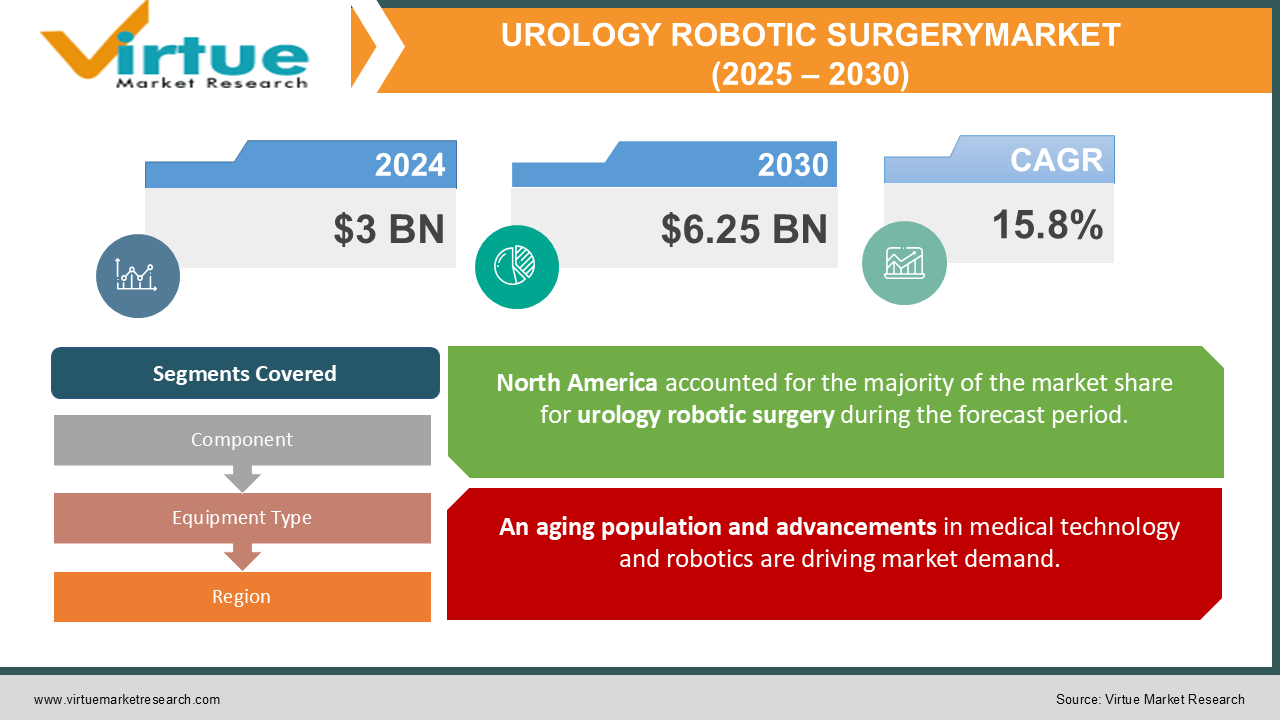Urology Robotic Surgery Market Size (2025 – 2030)
The Urology Robotic Surgery Market was valued at USD 3 billion and is projected to reach a market size of USD 6.25 billion by the end of 2030. Over the forecast period of 2025-2030, the market is projected to grow at a CAGR of 15.8%.
Over the past decade, advancements in robotics have opened its applications for many fields. Surgery and other medical procedures have started using robots to gain more precision and efficiency while performing surgery leading to much faster recovery times and better health of the patient. Miniaturized computer-controlled manipulators and surgical equipment with a video camera and artificial sensing technologies are used in urology robotic surgery, a minimally invasive procedure. For doctors to examine highly magnified and clear three-dimensional (3D) images of the area to be operated on, these devices are inserted into tiny punctures rather than big incisions using a variety of robotic consoles under the supervision of medical specialists.
Key Market Insights:
-
While this technology is changing the way surgery works, it remains inaccessible to a large part of the population even in the West. This has to do with the enormous costs that come with the use of robotics and insurers being unwilling to cover expensive treatments. Emerging market economies also do not have the same access to this technology as doctors might in the West.
-
Companies like Intuitive Surgical, Medtronic, and CMR Surgical are investing heavily in research and development to improve surgical outcomes. The integration of artificial intelligence (AI) and machine learning into robotic platforms is enhancing real-time decision-making and increasing the efficiency of procedures.
Urology Robotic Surgery Market drivers
An aging population and advancements in medical technology and robotics are driving market demand.
The increasing demand for urology robotic surgery is largely driven by the aging population and breakthroughs in medical technology and robotics. As life expectancy rises globally, there is a higher prevalence of age-related urological conditions such as prostate cancer, kidney disease, and urinary incontinence, necessitating advanced surgical interventions. Traditional open surgeries often pose higher risks and longer recovery times for elderly patients, making minimally invasive robotic-assisted procedures a preferred alternative. Simultaneously, rapid advancements in robotic technology, including AI-powered surgical systems, enhanced imaging, and improved instrument precision, have revolutionized urological surgeries by offering greater accuracy, reduced complications, and faster recovery. These innovations, combined with the growing acceptance of robotic-assisted techniques in hospitals and surgical centers, are making these procedures more accessible and efficient, further driving market growth.
Urological disorders are also increasing with lifestyle changes, minimally invasive procedures are becoming the norm as they help with a faster recovery.
Lifestyle changes, including sedentary habits, poor dietary choices, and rising obesity rates, have contributed to a growing prevalence of urological disorders such as kidney stones, urinary incontinence, and benign prostatic hyperplasia (BPH). Additionally, factors like smoking, high alcohol consumption, and increased stress levels have been linked to a higher incidence of prostate and bladder cancers. As these conditions become more widespread, there is a growing demand for effective treatment options that minimize patient discomfort and recovery time. Minimally invasive robotic-assisted procedures have emerged as the preferred choice due to their ability to reduce surgical trauma, lower infection risks, and shorten hospital stays. Unlike traditional open surgeries, robotic-assisted techniques provide enhanced precision, better visualization, and greater control, leading to improved patient outcomes. With advancements in robotic technology, such as AI integration and enhanced imaging capabilities, these procedures are becoming even more efficient, reinforcing the trend toward minimally invasive urological surgeries as the standard of care.
Urology Robotics Surgery Market Restraints and Challenges:
The robotic systems required for surgery are very expensive and not covered by a lot of insurers, also this technology is limited in access and availability.
The urology robotic surgery market faces several challenges despite its rapid growth. One of the primary restraints is the high cost of robotic surgical systems, which require significant upfront investment along with ongoing maintenance and disposable instrument expenses, making them less accessible for many healthcare providers, especially in developing regions. Additionally, the availability of these procedures remains limited due to the need for specialized training, as robotic surgery demands expertise that not all surgeons possess, leading to a shortage of qualified professionals. Regulatory hurdles also pose a challenge, as new robotic systems must undergo strict approval processes from authorities like the FDA and EMA, delaying market entry.
Urology Robotics Surgery Market Opportunities:
Because these are minimally invasive types of surgeries, they provide better precision and visualization with the help of technology and this leads to better patient outcomes. There are many opportunities in this market particularly in making the technology cost effective. Additionally, advancements in artificial intelligence, machine learning, and augmented reality are creating new possibilities for improved precision, real-time decision-making, and better patient outcomes, further enhancing the effectiveness of robotic-assisted surgeries. Emerging markets also offer substantial growth potential as governments and private healthcare providers invest in modernizing medical facilities. With rising medical tourism in countries like India, Thailand, and Brazil, there is increasing demand for advanced surgical procedures, including robotic-assisted urological surgeries.
UROLOGY ROBOTIC SURGERY MARKET REPORT COVERAGE:
|
REPORT METRIC |
DETAILS |
|
Market Size Available |
2024 - 2030 |
|
Base Year |
2024 |
|
Forecast Period |
2025 - 2030 |
|
CAGR |
15.8% |
|
Segments Covered |
By Component, Equipment Type, and Region |
|
Various Analyses Covered |
Global, Regional & Country Level Analysis, Segment-Level Analysis, DROC, PESTLE Analysis, Porter’s Five Forces Analysis, Competitive Landscape, Analyst Overview on Investment Opportunities |
|
Regional Scope |
North America, Europe, APAC, Latin America, Middle East & Africa |
|
Key Companies Profiled |
Asensus Surgical, Stryker Corporation, Intuitive Surgical, CMR Surgical, Medtronic Plc, Titan Medical Inc, Think Surgical, Siemens Healthineers, Accuray Incorporated, Johnson & Johnson |
Urology Robotic Surgery Market Segmentation: By Component
-
Robotic Surgery Systems
-
Services
-
Instruments and Accessories
The Robotic Surgery System accounts for the largest capital costs in this market. These systems, including platforms like the da Vinci Surgical System, enable precision in urological procedures such as prostatectomies and kidney surgeries. However, the high price of these systems—often exceeding $1.5 million per unit—can be a barrier to entry, particularly in cost-sensitive markets. As a result, companies are focusing on developing compact and cost-effective robotic platforms to improve accessibility and affordability.
Service contracts, which can cost hospitals $100,000 to $150,000 annually, contribute to recurring revenue for manufacturers. Additionally, the rising focus on remote surgical assistance and AI-powered predictive maintenance is further driving growth in this segment. The Instruments and Accessories segment is the fastest-growing one among the three and accounts for almost 50% of the market revenue.
Urology Robotic Surgery Market Segmentation: By Equipment Type
-
Navigation Systems
-
Robot Machines
-
Planners and Simulators
Navigation systems are essential for improving accuracy in robotic-assisted surgeries by providing real-time imaging, 3D mapping, and AI-driven guidance. These systems help surgeons plan and execute procedures with greater precision, reducing complications and improving patient outcomes. Robot machines constitute the core of the market, encompassing robotic-assisted surgical systems like the da Vinci platform and newer alternatives from Medtronic and CMR Surgical.
The planners and simulators segment is also expanding, driven by the rising need for surgeon training and preoperative planning. Advanced simulators enable robotic surgeons to practice complex procedures in a risk-free virtual environment, improving skill development and reducing surgical errors.
Urology Robotic Surgery Market Segmentation: By Region
-
North America
-
Asia Pacific
-
Europe
-
South America
-
Middle East and Africa
North America is the leading market for this technology with the US having the largest use and revenue generation from it, Europe also is leading in innovation technology for this industry. This stems from the fact that both regions have well-established medical systems high insurance rates and favorable reimbursement policies. The presence of key players like Intuitive Surgical, Medtronic, and Stryker further fuels growth in the region.
The Asia-Pacific region is emerging as the fastest-growing market, propelled by rising healthcare investments, medical tourism, and an increasing burden of urological diseases. Countries like China, India, and Japan are witnessing rapid adoption of robotic-assisted surgeries, driven by improving healthcare access and technological advancements. Meanwhile, South America and the Middle East & Africa are still in the early stages of adoption due to limited access to advanced robotic systems and high costs.
COVID-19 Impact Analysis on the Urology Robotic Surgery Market:
Covid 19 came at a critical time for the market. The impact of the pandemic on health increased the investments in the tech space which focused on healthcare equipment. This spurred investments in robotics which translated into demand for this market increasing rapidly. However, Supply chain disruptions also delayed the manufacturing and delivery of robotic surgical systems and instruments, affecting market growth. The pandemic accelerated the adoption of remote surgical training and AI-driven robotic platforms, allowing for continued skill development despite restrictions on in-person learning. Additionally, as healthcare systems rebuild, many hospitals are now investing in advanced robotic technologies to enhance surgical efficiency and patient outcomes.
Key Trends/ Developments:
One of the most significant trends is the integration of artificial intelligence (AI) and machine learning into robotic surgical systems. AI-powered platforms enhance real-time decision-making, precision, and automation, leading to better surgical outcomes. Additionally, haptic feedback technology is being developed to improve surgeon control by providing a sense of touch, which enhances dexterity and accuracy in complex urological procedures.
Another major development is the emergence of cost-effective robotic systems, making these technologies more accessible to smaller hospitals and emerging markets. Additionally, telesurgery and remote-assisted procedures are gaining traction, enabling expert surgeons to assist or even perform surgeries remotely using 5G and advanced robotic interfaces.
In 2023, Intuitive Surgical expanded its AI capabilities and real-time analytics to enhance surgeon precision. The company also focuses on leasing models to make robotic systems more affordable for smaller hospitals.
Stryker Corporation is investing in AI-powered robotic navigation and planning tools, aiming to improve the precision of urological cancer surgeries and reconstructive procedures.
Key Players:
-
Asensus Surgical
-
Stryker Corporation
-
Intuitive Surgical
-
CMR Surgical
-
Medtronic Plc
-
Titan Medical Inc
-
Think Surgical
-
Siemens Healthineers
-
Accuray Incorporated
-
Johnson & Johnson
Chapter 1. Urology Robotic Surgery Market – Scope & Methodology
1.1 Market Segmentation
1.2 Scope, Assumptions & Limitations
1.3 Research Methodology
1.4 Primary Sources
1.5 Secondary Sources
Chapter 2. Urology Robotic Surgery Market – Executive Summary
2.1 Market Size & Forecast – (2025 – 2030) ($M/$Bn)
2.2 Key Trends & Insights
2.2.1 Demand Side
2.2.2 Supply Side
2.3 Attractive Investment Propositions
2.4 COVID-19 Impact Analysis
Chapter 3. Urology Robotic Surgery Market – Competition Scenario
3.1 Market Share Analysis & Company Benchmarking
3.2 Competitive Strategy & Development Scenario
3.3 Competitive Pricing Analysis
3.4 Supplier-Distributor Analysis
Chapter 4. Urology Robotic Surgery Market - Entry Scenario
4.1 Regulatory Scenario
4.2 Case Studies – Key Start-ups
4.3 Customer Analysis
4.4 PESTLE Analysis
4.5 Porters Five Force Model
4.5.1 Bargaining Power of Suppliers
4.5.2 Bargaining Powers of Customers
4.5.3 Threat of New Entrants
4.5.4 Rivalry among Existing Players
4.5.5 Threat of Substitutes
Chapter 5. Urology Robotic Surgery Market – Landscape
5.1 Value Chain Analysis – Key Stakeholders Impact Analysis
5.2 Market Drivers
5.3 Market Restraints/Challenges
5.4 Market Opportunities
Chapter 6. Urology Robotic Surgery Market – By Component
6.1 Introduction/Key Findings
6.2 Robotic Surgery Systems
6.3 Services
6.4 Instruments and Accessories
6.5 Y-O-Y Growth trend Analysis By Component
6.6 Absolute $ Opportunity Analysis By Component, 2025-2030
Chapter 7. Urology Robotic Surgery Market – By Equipment Type
7.1 Introduction/Key Findings
7.2 Navigation Systems
7.3 Robot Machines
7.4 Planners and Simulators
7.5 Y-O-Y Growth trend Analysis By Equipment Type
7.6 Absolute $ Opportunity Analysis By Equipment Type, 2025-2030
Chapter 8. Urology Robotic Surgery Market , By Geography – Market Size, Forecast, Trends & Insights
8.1 North America
8.1.1 By Country
8.1.1.1 U.S.A.
8.1.1.2 Canada
8.1.1.3 Mexico
8.1.2 By Component
8.1.3 By Equipment Type
8.1.4 Countries & Segments - Market Attractiveness Analysis
8.2 Europe
8.2.1 By Country
8.2.1.1 U.K
8.2.1.2 Germany
8.2.1.3 France
8.2.1.4 Italy
8.2.1.5 Spain
8.2.1.6 Rest of Europe
8.2.2 By Component
8.2.3 By Equipment Type
8.2.4 Countries & Segments - Market Attractiveness Analysis
8.3 Asia Pacific
8.3.1 By Country
8.3.1.1 China
8.3.1.2 Japan
8.3.1.3 South Korea
8.3.1.4 India
8.3.1.5 Australia & New Zealand
8.3.1.6 Rest of Asia-Pacific
8.3.2 By Component
8.3.3 By Equipment Type
8.3.4 Countries & Segments - Market Attractiveness Analysis
8.4 South America
8.4.1 By Country
8.4.1.1 Brazil
8.4.1.2 Argentina
8.4.1.3 Colombia
8.4.1.4 Chile
8.4.1.5 Rest of South America
8.4.2 By Component
8.4.3 By Equipment Type
8.4.4 Countries & Segments - Market Attractiveness Analysis
8.5 Middle East & Africa
8.5.1 By Country
8.5.1.1 United Arab Emirates (UAE)
8.5.1.2 Saudi Arabia
8.5.1.3 Qatar
8.5.1.4 Israel
8.5.1.5 South Africa
8.5.1.6 Nigeria
8.5.1.7 Kenya
8.5.1.8 Egypt
8.5.1.9 Rest of MEA
8.5.2 By Component
8.5.3 By Equipment Type
8.5.4 Countries & Segments - Market Attractiveness Analysis
Chapter 9. Urology Robotic Surgery Market – Company Profiles – (Overview, Product Portfolio, Financials, Strategies & Developments)
9.1 Asensus Surgical
9.2 Stryker Corporation
9.3 Intuitive Surgical
9.4 CMR Surgical
9.5 Medtronic Plc
9.6 Titan Medical Inc
9.7 Think Surgical
9.8 Siemens Healthineers
9.9 Accuray Incorporated
9.10 Johnson & Johnson
Download Sample
Choose License Type
2500
4250
5250
6900
Related Reports
Frequently Asked Questions
The urology robotic surgery market was valued at USD 3 billion in 2024 and is projected to reach USD 6.25 billion by 2030, growing at a CAGR of 15.8% over the forecast period.
The primary market drivers include the aging population, increasing cases of urological disorders (such as prostate cancer and kidney diseases), and technological advancements in AI-driven robotic surgery systems.
The high cost of robotic surgical systems, limited insurance reimbursement in some regions, and shortage of trained robotic surgeons pose significant challenges. Additionally, regulatory approvals for new robotic systems can be time-consuming, slowing market entry for emerging companies.
North America leads the market due to its well-established healthcare infrastructure, high insurance coverage, and strong presence of key industry players like Intuitive Surgical and Medtronic. Europe follows while Asia-Pacific is the fastest-growing region, driven by rising healthcare investments, medical tourism, and increasing adoption of robotic surgery.
Major companies operating in the urology robotic surgery market include Intuitive Surgical, Medtronic, CMR Surgical, Stryker Corporation, Asensus Surgical, Johnson & Johnson, Titan Medical, THINK Surgical, Siemens Healthineers, and Accuray Incorporated.




